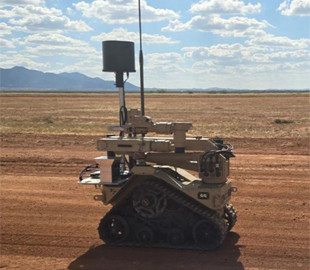
The American company L3Harris has upgraded its T7 robot, which is an unmanned ground vehicle, with advanced electronic warfare capabilities, making it more effective on the battlefield, writes Interesting Engineering.
Now the robot can detect and disable enemy communications, radars and electronic signals at a distance of several kilometers, protecting military units from threats.
“Successfully tested in US Army exercises, the robot neutralized small drones and demonstrated its ability to operate remotely. The electronic warfare system can be turned on or off as needed, allowing the T7 to minimize the risk of detection by turning off its own signals and moving quickly,” the article explained.
In addition, the T7 can pick up downed friendly drones or deploy small unmanned aerial systems using a robotic arm, which adds versatility to its missions.
The publication recalled that T7 is a robot designed to perform tasks during military operations, including cleaning from hazardous chemicals, demining explosive devices, reconnaissance, surveillance and reconnaissance, as well as SWAT missions.
“The electronic warfare equipment used is the CORVUS-RAVEN anti-drone system, which provides operators with passive signal detection, improved situational awareness, and jamming capabilities,” the authors noted.
It is noted that the modernized T7 successfully detected and neutralized small unmanned aerial vehicles using the CORVUS-RAVEN system, while simultaneously detecting, tracking and decoding electronic signals using an individual CORVUS node.
At the same time, Western countries emphasize the importance of electronic warfare capabilities, especially against the backdrop of the war in Ukraine, where protection in confrontation conditions and the survival of mobile forces against artillery strikes have become critically important.
The company emphasized that such tests showed the need for advanced electronic warfare systems to increase awareness on the battlefield and protect personnel from disruption of communications and enemy surveillance.
In turn, the chief robotics engineer L3Harris emphasized that the ability to remotely activate and neutralize EW effects allows these robots to minimize the risks of detection. By turning off their own signals and quickly changing location, they can avoid becoming targets for enemy artillery.
“The T7 and T4 robots are particularly well suited for deployed EW missions thanks to aerospace-grade shielding that protects them from electromagnetic interference (EMI). This allows them to work with the CORVUS system without degrading performance. In addition, the low level of radiation ensures that they will not interfere with the CORVUS system when it is actively scanning for enemy signals,” the material added.

